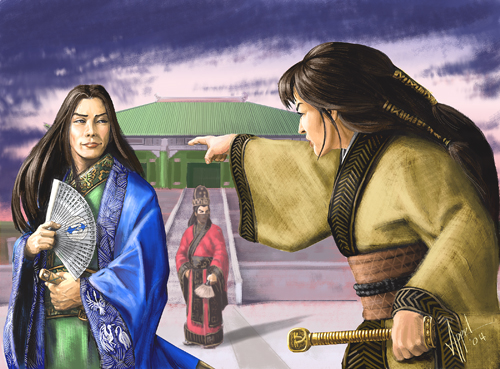At its core, the Legend of the Five Rings Role-playing Game uses a very simple mechanic. When a player wishes to have his character take an action, the Game Master determines what abilities the character should use to determine success or failure (these abilities most often consist of one Trait and one Skill used in conjunction with one another). The Game Master must also decide how difficult the task should be, and choose a Target Number (TN) based on this difficulty. The player rolls a number of ten-sided dice based upon the abilities on the samurai’s character sheet that the Game Master has identifi ed as necessary for the task. The player then adds the total of the dice rolled and compares the sum to the TN chosen by the Game Master. If the total meets or exceeds the TN, the character successfully completed the task in question. If the total is less than the TN, the character has failed to complete the task.
 It is rare that a player will keep all of the dice rolled when his character is taking an action. Typically, a player can keep a smaller number of dice than the amount rolled, and in almost all situations the player will choose the highest rolling of the dice, although he may keep whichever ones he chooses; if for some reason he wishes for his character to fail the roll in question, he may choose lower rolling dice. When denoting the number of dice that should be rolled and kept, the format used is XkY, where X represents the number of dice rolled, or “rolled dice,” and Y the number of dice kept, or “kept dice.” For example, the notation 4k2 means that four dice should be rolled and two of them chosen to be kept and added together; if the player rolled a 3, 6, 7, and 9, the player would likely choose the 7 and 9 for a total of 16 on the roll.
It is rare that a player will keep all of the dice rolled when his character is taking an action. Typically, a player can keep a smaller number of dice than the amount rolled, and in almost all situations the player will choose the highest rolling of the dice, although he may keep whichever ones he chooses; if for some reason he wishes for his character to fail the roll in question, he may choose lower rolling dice. When denoting the number of dice that should be rolled and kept, the format used is XkY, where X represents the number of dice rolled, or “rolled dice,” and Y the number of dice kept, or “kept dice.” For example, the notation 4k2 means that four dice should be rolled and two of them chosen to be kept and added together; if the player rolled a 3, 6, 7, and 9, the player would likely choose the 7 and 9 for a total of 16 on the roll.
 It is rare that a player will keep all of the dice rolled when his character is taking an action. Typically, a player can keep a smaller number of dice than the amount rolled, and in almost all situations the player will choose the highest rolling of the dice, although he may keep whichever ones he chooses; if for some reason he wishes for his character to fail the roll in question, he may choose lower rolling dice. When denoting the number of dice that should be rolled and kept, the format used is XkY, where X represents the number of dice rolled, or “rolled dice,” and Y the number of dice kept, or “kept dice.” For example, the notation 4k2 means that four dice should be rolled and two of them chosen to be kept and added together; if the player rolled a 3, 6, 7, and 9, the player would likely choose the 7 and 9 for a total of 16 on the roll.
It is rare that a player will keep all of the dice rolled when his character is taking an action. Typically, a player can keep a smaller number of dice than the amount rolled, and in almost all situations the player will choose the highest rolling of the dice, although he may keep whichever ones he chooses; if for some reason he wishes for his character to fail the roll in question, he may choose lower rolling dice. When denoting the number of dice that should be rolled and kept, the format used is XkY, where X represents the number of dice rolled, or “rolled dice,” and Y the number of dice kept, or “kept dice.” For example, the notation 4k2 means that four dice should be rolled and two of them chosen to be kept and added together; if the player rolled a 3, 6, 7, and 9, the player would likely choose the 7 and 9 for a total of 16 on the roll.

Comments (0)